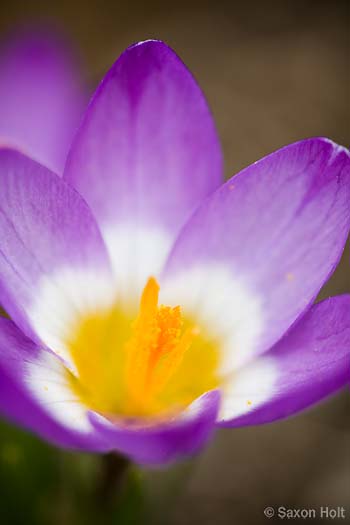
Tulipa saxatilis or Crocus 'Tricolor' ? (see comments) 2.21.09
What is the point of a photograph ? I ask this question every time I click the shutter. Why am I taking this picture and what am I trying to say ? This is one of the fundamental keys to taking a good garden photograph. The reason to take the picture may be a simple documentation of what the garden looks like on any given day, but more often for me, as a professional garden photographer, I need to have a point of view. I want to communicate an idea, a feeling, or an impression.
Often my point of view in making the picture is inextricably linked to the point of view of the camera.
The diminutive Tulipa saxtilis (Crocus ?) have just bloomed in my garden. They lasted maybe two days and the rains beat them down. Fragile beauty I was lucky to notice. The view point of my camera is looking straight into the flower, focused on the stigma. In close up photos of flowers, when there is very little depth of field, I have found it best to focus on the pistil or stamen and let the color go out of focus.
But that photo does not really communicate the scale of the flower, or even that it is in a garden, or much about the season.
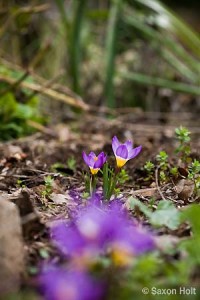 Here we see not only that the flowers are small, we see they are rather isolated in the garden; due, no doubt, to their popularity with the pocket gophers.
Here we see not only that the flowers are small, we see they are rather isolated in the garden; due, no doubt, to their popularity with the pocket gophers.
Note the point of view of this photograph is looking overtop another clump to add more color and give a sense of depth while showing the smallness of this little bulb. I have left lots of room at the top of the frame that adds to the scale.
What you don’t note in this photo’s point of view is that I am on my belly. As I said in the beginning – my point of view in making the picture is inextricably linked to the point of view of the camera.
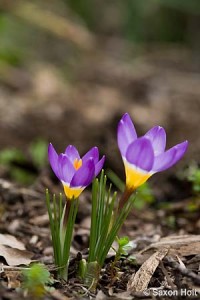
This next view is also a belly shot, as I inch closer to the flower. This is a harder technique than it sounds. Not just because of the middle age problems of getting up and down off the ground but the problem of finding enough room in a garden to lay flat out, to hold the camera steady, focus, and compose a decent shot.
Note the compositions again, allowing extra room at the top. This sort of framing allows room for type just in case some editor decides to publish this as a cover of a magazine.
As long as I am on the ground I may as well look around for other photos that can be taken from this point of view.
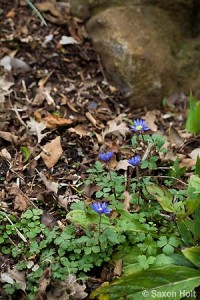 Here are the little Grecian windflowers (Anemone blanda) poking out from last year’s mulch. Point of view – standing, looking down.
Here are the little Grecian windflowers (Anemone blanda) poking out from last year’s mulch. Point of view – standing, looking down.
If I want to make a portrait shot of this small flower, I need to get close. But simply stooping down on top of the flower will yield a photo with little depth of field. The flowers are on comparatively long stalks and the foliage would all but disappear on a typical macro shot.
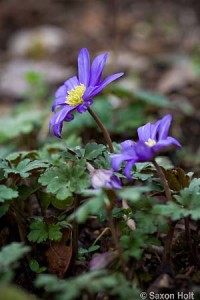 So let’s go back back to a belly view. Now we really begin to show this pretty little flower. We are so close to it one could image an entire garden groundcover.
So let’s go back back to a belly view. Now we really begin to show this pretty little flower. We are so close to it one could image an entire garden groundcover.
Depth of field is very shallow this close, so I am careful to move my point of view (by millimeters) until two flowers are almost side by side so that they both fall into my focal plane.
And now that we are down here studying the miraculous awakening of spring and quiet beauty of these too blue to be true flowers, we see a new flower, curled in the cluster of leaves. See it, out of focus tucked under ?
In this tiny flower about to unfold is a new point of view, a new idea to share. In this delicate and quiet moment, a single flower is about to stand up, join its brethren, and cheer on the season – you will miss it if you don’t look for it.
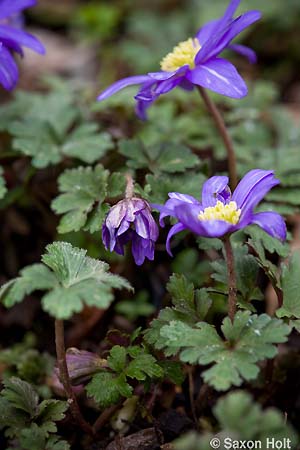
The point of view of the camera and of the subject are now the same.
